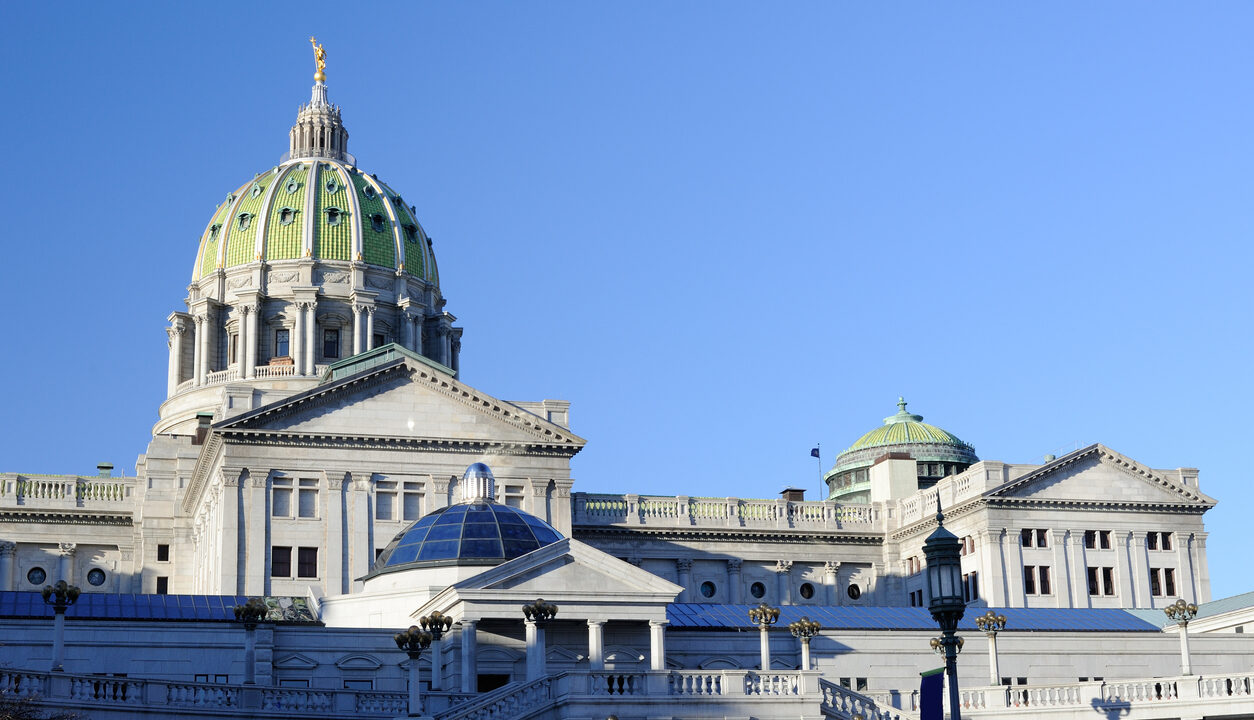Fact Sheet

Proposed Tax Cuts and the 2024 State Budget
Key Points
- A responsible budget in fiscal year (FY) 2024–25 must grapple with Pennsylvania’s aging and shrinking workforce challenges through sound tax and regulatory reform.
- State Senate Republicans proposed two tax cuts to improve Pennsylvania’s competitiveness.
- Senate Bill (SB) 269 proposes a 9 percent reduction to the Personal Income Tax (PIT) rate beginning in January 2025.[1]
- SB 269 also proposes eliminating the Gross Receipts Tax (GRT) on electricity. The surcharge on consumer electricity bills collected $1.16 billion in revenue this fiscal year.
- The tax cuts would save $400 per family of four in FY 2024-25 and increase to $900 per family of four in FY 2025-26.
- Tax cuts should pair with sound spending restraint to reduce Pennsylvania’s structural deficit.
Pennsylvania’s Structural Deficit
- Shapiro’s budget, as proposed, spends $3 billion more than revenues this year and creates a structural deficit of more than $6 billion by 2028.[2],[3] His plan would illegally drain state reserves by the end of 2026, requiring massive spending cuts or tax hikes on working families.[4]
- In contrast, the proposed tax reductions would forgo $1.3 billion in revenues and address the demographic trends driving higher state spending.
- Pennsylvania, year over year, loses its working-age population to other states. Better jobs and pocketbook issues are the main drivers behind the “exodus.”[5]
- According to the Independent Fiscal Office (IFO), Pennsylvania’s working-age population will fall 2.6 percent between 2020 and 2025 and an additional 1.7 percent between 2025 and 2030, resulting in an adverse “dependency ratio” shift from 3.5 working adults per senior to 2.5 by 2030.[6] This shift will have a drastic impact on state finances.
- Fewer working-age adults means lower PIT collections, while expensive programs that serve seniors, like Long-Term Care, will grow. The IFO projects a 5.9 percent average annual growth rate for Long-Term Care, far outpacing the projected General Fund revenue average annual increase of 2.7 percent over the next five years.[7]
Proposed Tax Cuts
- SB 269 proposes reducing the PIT from 3.07 percent to 2.8 percent beginning in January 2025.
- This returns the PIT rate to where it was in 2003 before former Gov. Ed Rendell’s tax increase.[8]
- According to the Tax Foundation, Pennsylvania’s PIT rate is the 12th lowest in the nation, including states with no PIT. Under this proposal, Pennsylvania would levy the 10th lowest rate.[9]
- Since the pandemic, states have been pursuing tax cuts to become more economically competitive. Fourteen states have already reduced their individual income tax rate in 2024.[10]
- Reducing the PIT benefits small businesses. Approximately 825,000 small business owners in Pennsylvania pay the PIT versus the Corporate Net Income Tax (CNIT).[11]
- SB 269 also proposes eliminating the GRT on electricity of 59 mills. This tax on electricity sales currently passes on to consumers as a surcharge. Unlike the PIT, a portion of GRT revenues fund specific programs in the state budget. The proposal transfers $6 million from the General Fund to the Alternative Fuels Incentive Fund to replace GRT revenue.
- The Alternative Fuels Incentive Fund provides grants for local governments and non-profits that want to transition to transportation options such as compressed natural gas, electric vehicles, hydrogen, ethanol, and other biofuels.[12]
- These tax cuts would reduce state revenue by $1.3 billion in 2024–25 and save the average family of four nearly $400. A full year of these tax reductions would save a family of four nearly $900, with state revenues declining by $3 billion.
More Ways to Make Pennsylvania“Open to Business”
- The proposed tax cuts would spur job creation and economic growth, but there are more tax reductions that Shapiro and Senate leaders support.
- The budget should accelerate the reduction of the CNIT. Moving Pennsylvania from one of the highest CNIT rates to among the lowest will improve the state’s competitiveness. Pennsylvania must keep pace as tax reductions occur across the country. In 2024 alone, six states lowered the corporate tax rate.[13]
- The state can further improve by ending the startup penalty.[14] Pennsylvania is one of only two states that cap how much corporations can deduct in losses and where small businesses cannot deduct any losses. Enacting net operating loss reforms would encourage more business startups.[15]
[1]Sen. Chris Gebhard, Senate Bill 269, Pennsylvania General Assembly, Regular Session 2023–24, https://www.legis.state.pa.us/cfdocs/billInfo/billInfo.cfm?sYear=2023&sInd=0&body=S&type=B&bn=0269.
[2]Pennsylvania Independent Fiscal Office, “FY 2024–25 Budget Hearing: Senate Appropriations Committee,” February 2024, http://www.ifo.state.pa.us/download.cfm?file=Resources/Documents/IFO_Hearing_Materials_02_2024.pdf.
[3]Pennsylvania House Republicans Appropriations Committee, “Pennsylvania’s Structural Deficit,” https://www.pahousegop.com/Display/SiteFiles/426/2024Budget/PA%20Structural%20Deficit.pdf.
[4]Commonwealth Foundation, “Shapiro’s Structural Deficit,” February 28, 2024, https://commonwealthfoundation.org/research/shapiro-structural-deficit/; Commonwealth Foundation, “State Law, Financial Experts, and the Governor Himself Condemn Budget Plan to Raid Rainy Day Fund,” news release, February 19, 2024, https://commonwealthfoundation.org/2024/02/19/shapiro-budget-rainy-day-fund/.
[5]Commonwealth Foundation, “Pa.’s Population Continues Its Troubling Decline,” news release, December 20, 2023, https://commonwealthfoundation.org/2023/12/20/pa-population-decline/.
[6]Matthew J. Knittel, “Pennsylvania Economic and Budget Outlook: Fiscal Years 2023–24 to 2028–29,” (Harrisburg, PA: Independent Fiscal Office, November 2023), 1, 5–7, http://www.ifo.state.pa.us/download.cfm?file=Resources/Documents/Five_Year_Outlook_2023.pdf.
[7]Knittel, “Pennsylvania Economic and Budget Outlook: Fiscal Years 2023–24 to 2028–29,” 30–32.
[8]Pennsylvania Department of Revenue, Personal Income Tax Rates, accessed May 21, 2023, https://www.revenue.pa.gov/Tax%20Rates/Pages/Personal%20Income%20Tax%20Rates.aspx; Former Gov. Ed Rendell, “The One Time I Was Wrong,” Philadelphia Inquirer, November 27, 2019, https://www.inquirer.com/opinion/commentary/ed-rendell-pennsylvania-governor-tax-raise-first-term-20191127.html#loaded.
[9]Andrey Yushkov, “State Individual Income Tax Rates and Brackets, 2024,” Tax Foundation, February 20, 2024, https://taxfoundation.org/data/all/state/state-income-tax-rates-2024/.
[10]States that have reduced PIT in 2024: Arkansas, Connecticut, Georgia, Indiana, Iowa, Kentucky, Mississippi, Missouri, Montana, Nebraska, New Hampshire (interest and dividends income only), North Carolina, Ohio, and South Carolina.
[11]Pennsylvania Department of Revenue, Personal Income Tax Statistics, accessed May 22, 2024, https://www.revenue.pa.gov/News%20and%20Statistics/ReportsStats/PIT/Pages/default.aspx
[12]Department of Environmental Protection, Alternative Fuels Incentive Grant program, accessed May 21, 2024, https://www.dep.pa.gov/Citizens/GrantsLoansRebates/Alternative-Fuels-Incentive-Grant/Pages/default.aspx.
[13]Manish Bhatt and Benjamin Jaros, “State Tax Changes Taking Effect January 1, 2024,” Tax Foundation, December 21, 2023, https://taxfoundation.org/research/all/state/2024-state-tax-changes/.
[14]Sen. Greg Rothman, Senate Bill 346, Pennsylvania General Assembly, Regular Session 2023–24, https://www.legis.state.pa.us/cfdocs/billinfo/billinfo.cfm?syear=2023&sind=0&body=S&type=B&bn=346.
[15]Sen. Judy Ward, Senate Bill 662, Pennsylvania General Assembly, Regular Session 2023–24, https://www.legis.state.pa.us/cfdocs/billinfo/billinfo.cfm?syear=2023&sind=0&body=S&type=B&bn=0662.